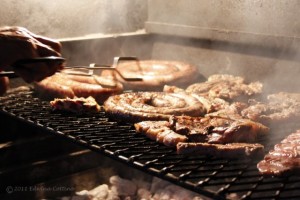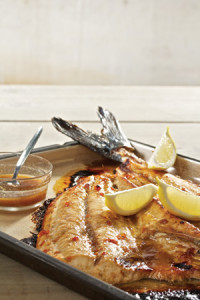Food you may get to eat on your Kruger National Park Safari
Please note: On our safaris you will have plenty of opportunity to enjoy these dishes, although dietary requirements are catered for, depending on your needs. This is just a brilliant example of everyday lovely foods eaten by the South African Nation.
Braai / BBQ
 The Braai (BBQ) is a traditional South African dish usually served on a Friday afternoon or on social occasions.
The Braai (BBQ) is a traditional South African dish usually served on a Friday afternoon or on social occasions.
It includes either lamb, beef or pork and boerewors (sossages).
24 September every year boasts heritage day and many South Africans know it as braai day, since this is usually the activity that we partake in.
On this day, South Africans across the spectrum are encouraged to celebrate their culture and the diversity of their beliefs and traditions, in the wider context of a nation that belongs to all its people.
Snoek with Apricot Jam
The snoek or Thyrsites atun is a long, thin species of snake mackerel found in the seas of the Southern Hemisphere.
This fish can reach a length of 200 centimetres (79 in) SL though most do not exceed 75 centimetres (30 in) SL. The maximum recorded weight for this species is 6 kilograms (13 lb). It is very important to commercial fisheries and is also a popular game fish. It is currently the only known member of its genus. It is also known in Australasia as barracouta though it is not related to the barracuda.
It is found off the coast of Namibia and the coast of the Western Cape and Northern Cape provinces of South Africa. It was originally called the “zeesnoek” (Sea Snoek) by Dutch colonists who arrived in the Cape in 1652. It is said to have reminded them of the freshwater pike (or snoek) they found at home in the Netherlands. The snoek is widely distributed in the colder waters in the Southern Hemisphere.
The snoek is a meal that is prepared on special occasions.
Biltong
 Biltong is a variety of dried, cured meat that originating from South Africa. Various types of meat are used to produce it, ranging from beef and game meats to fillets of ostrich from commercial farms.
Biltong is a variety of dried, cured meat that originating from South Africa. Various types of meat are used to produce it, ranging from beef and game meats to fillets of ostrich from commercial farms.
It is typically made from raw fillets of meat cut into strips following the grain of the muscle, or flat pieces sliced across the grain. It is similar to beef jerky in that they are both spiced, dried meats. The typical ingredients, taste and production processes differ, the main difference being that biltong is dried and subsequently sliced whereas jerky is sliced prior to drying.
Braaibrootjies / Toasties
This South African braai staple is usually served on white or brown bread; spread with lashings of butter on the outside, and filled with thick, juicy slices of tomato, onion and cheese on the inside.
It’s merely necessary to throw the sandwhich on the braai, and keep your salivating mouth occupied with an ice-cold beer until the bread is nice and toasted on the outside, and the mix is gooey in the middle.
Americans do it in style with their state-of-the-art barbeques; the Australians, on the other hand, like to throw some ‘shrimp on the barbie’; and we, South Africans, have perfected the delicate art of braai.
Prepared ostrich
 Pre-Grilled ostrich meat is easy to prepare and ready within minutes. The meat is only needs to be heated and served.
Pre-Grilled ostrich meat is easy to prepare and ready within minutes. The meat is only needs to be heated and served.
It is tender and juicy as well as great in taste. It tastes home-made and has a grilled appearance.
The controlled cooking process ensures consistent quality of the final product. Customers can be assured of meat that has a consistent moisture content to ensure juiciness and tenderness.
Bobotie
Bobotie is a South African dish consisting of spiced minced meat baked with an egg-based topping. Pronounced ba-boo-tea, the national dish of South Africa is a delicious mixture of curried meat and fruit with a creamy golden topping, not dissimilar to moussaka.
It is a famous dish of South Africa. It is thought to have originated from the Indonesian dish bobotok, which consisted of meat with a custard topping that was cooked in a pan of water until the egg mixture set.
Colonists from the Dutch East India Company colonies in Batavia probably introduced bobotie to South Africa. The first recipe for bobotie appeared in a Dutch cookbook in 1609.
Afterwards, it was taken to South Africa and adopted by the Cape Malay community. It is also made with curry powder leaving it with a slight “tang”. It is often served with Sambal.
The dish has been known in the Cape of Good Hope since the 17th century, when it was made with a mixture of mutton and pork. Today it is much more likely to be made with beef or lamb, although pork lends the dish extra moisture.
Chakalaka and Pap
 Chakalaka is a South African vegetable relish, usually spicy, that is traditionally served with bread, pap, samp, stews or curries. To balance its fiery flavour, it is sometimes served with amasi (thick sour milk).
Chakalaka is a South African vegetable relish, usually spicy, that is traditionally served with bread, pap, samp, stews or curries. To balance its fiery flavour, it is sometimes served with amasi (thick sour milk).
Chakalaka may have originated in the townships of Johannesburg. There are many variations on how to make Chakalaka, often depending on region and family tradition. Many versions include beans. For example, a tin of baked beans, tin of tomatoes, onion, garlic and some curry paste can be used to make the dish.
The dish is usually served with Boerewors and often contains flavours of tomato and union.
Chicken Biryani
Biryani (pronounced [bɪr.jaːniː]), sometimes spelt Biriyani or Biriani, is a mixed rice dish from the Indian Subcontinent. It is made with spices, rice and meat or vegetables.
[bɪr.jaːniː]), sometimes spelt Biriyani or Biriani, is a mixed rice dish from the Indian Subcontinent. It is made with spices, rice and meat or vegetables.
Although there are many varieties, it is mainly served with chicken in South Africa.
The word “biryani” is derived from the Persian language. One theory is that it originates from “birinj”, the Persian word for rice. Another theory is that it derives from “biryan” or “beriyan” (to fry or roast).
The origin of biryani is uncertain. In North India, it is traditionally associated with the Mughlai cuisine of Delhi and the Awadhi cuisine of Lucknow; in South India, it is traditionally associated with the Hyderabadi cuisine.
Potjiekos
 In South Africa, potjiekos ˈpɔɪkiːkɒs, literally translated “small pot food”, is a stew prepared outdoors. It is traditionally cooked in a round, cast iron, three-legged pot, the potjie, descended from the Dutch oven brought from the Netherlands to South Africa in the 17th century and found in the homes and villages of people throughout southern Africa.
In South Africa, potjiekos ˈpɔɪkiːkɒs, literally translated “small pot food”, is a stew prepared outdoors. It is traditionally cooked in a round, cast iron, three-legged pot, the potjie, descended from the Dutch oven brought from the Netherlands to South Africa in the 17th century and found in the homes and villages of people throughout southern Africa.
Traditionally, the recipe includes meat, vegetables like carrots, cabbage, cauliflower or pumpkin, starches like rice or potatoes, all slow-cooked with Dutch-Malay spices, the distinctive spicing of South Africa’s early culinary melting pot. Other common ingredients include fruits and flour-based products like pasta.
The pot is heated using small amounts of wood or charcoal.
Koeksisters
 A koeksister (or koe’sister) derives from the Dutch word koekje, which translates to “cookie”. There are two popular versions of this South African syrup-coated doughnut: an Afrikaner version which is a twisted or braided shape (like a plait) and a Cape Malay version which is a spicy treat finished off with a sprinkling of coconut.
A koeksister (or koe’sister) derives from the Dutch word koekje, which translates to “cookie”. There are two popular versions of this South African syrup-coated doughnut: an Afrikaner version which is a twisted or braided shape (like a plait) and a Cape Malay version which is a spicy treat finished off with a sprinkling of coconut.
It is prepared by deep-frying plaited dough rolls in oil, then dipping the fried dough into cold sugar syrup. Koeksisters are very sticky and sweet and taste like honey.
Milk Tart
 Melktert, which means “milk tart” in Afrikaans, is a South African dessert consisting of a sweet pastry crust containing a creamy filling made from milk, flour, sugar and eggs. The ratio of milk to egg is higher than in a traditional Portuguese custard tart (Pastéis de nata[1]) or Chinese egg tart, in which both was influenced by the Portuguese, resulting in a lighter texture and a stronger milk flavour. Some recipes require the custard to be baked in the crust, and others call for the custard to be prepared in advance, and then placed in the crust before serving. Cinnamon is often sprinkled over its surface. The milk used for the custard can also be infused with a cinnamon stick before preparation.
Melktert, which means “milk tart” in Afrikaans, is a South African dessert consisting of a sweet pastry crust containing a creamy filling made from milk, flour, sugar and eggs. The ratio of milk to egg is higher than in a traditional Portuguese custard tart (Pastéis de nata[1]) or Chinese egg tart, in which both was influenced by the Portuguese, resulting in a lighter texture and a stronger milk flavour. Some recipes require the custard to be baked in the crust, and others call for the custard to be prepared in advance, and then placed in the crust before serving. Cinnamon is often sprinkled over its surface. The milk used for the custard can also be infused with a cinnamon stick before preparation.

